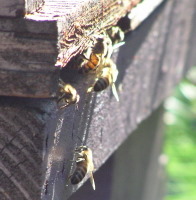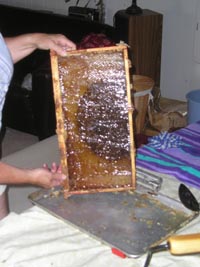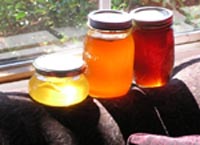 Raising Honey Bees
Raising Honey Bees
I love my ‘girls’. They are so industrious and inspirational. They all have a role to play and they do it well. It inspires me
to go to the hives on a nice sunny day and just pull up a chair and watch them.
I get asked all the time ‘how many times have you been
stung”? I’ve been doing this four years and I’ve only been stung
once and that was because I had on flip flops and stepped on one. My girls let
me know when they don’t want my company. I can usually tell their ‘mood’
by the sound of the hive. If all is well it is a happy humming sound, but if
they are being pestered by yellow jackets or too hot or just in a bad mood, they
will be much louder and I will step back and let them alone. They will bounce
off your forehead as a warning for you to back off. If that happens, I respect
their wishes and leave them alone.
I also get asked “why did you get started raising
bees”? My mother had cancer and she switched to honey as a sweetener. The
price of honey skyrocketed due to colony collapse disorder and it was really
expensive for her. So I thought to myself “how hard can it be”? I went to a
class at the UW Arboretum taught by the Puget Sound Bee Keepers Association and
gathered the information I needed. My mother is a beautiful 10 year cancer
survivor and has all the honey she wants.
I had the opportunity to buy hives from a guy
who was going out of business. He told me to stop by and see his mentor Harvard
Robbins on my way home.

I
did and Harvard said ‘hey, tomorrow I’m going to California to pick up bees,
you want some”? Suddenly and
quite unexpectedly, I was a beekeeper. I ran to the bookstore and bought a book
called Beekeeping for Dummies the to Home Depot and bought a paper painters
suit and a pair of rubber gloves. I was freaked out when I got my girls home but
once they were in their boxes they just took over and I stepped away.
I know you are supposed to be checking on their egg laying
pattern and observing the queen, etc. But I don’t. My philosophy is to leave
them alone. If they look crowded or hot I will add a new box. I also don’t
like to smoke them. It frightens them and slows down their honey production. On
the other hand if it’s the only day I have to work them and they are in a bad
mood I will smoke them just long enough to extract their frames to spin honey.
Honey harvest day is the only day I will use my smoker.
It’s been a really rewarding hobby and I love doing it. I
give honey as gifts, make honey mustard, honey bran muffins, honey butter, just
about anything you can make with honey. Our first year we got 7 gallons off two
hives. We haven’t gotten as much since, but it still plenty of honey for us
and our family.
Here’s a picture of the different seasons of honey.
The light honey is spring, the middle is summer and the dark is fall. We
harvested three times that year because they were getting too full and needed
the room.
.







 I
I